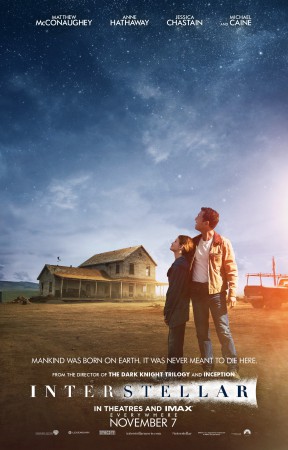One year ago exactly, in november 2014, the Hollywood blockbuster and science-fiction movie Interstellar was released on screens and much mediatic excitation arose about it.
This is the first of a series of 6 posts devoted to the analysis of some of the scientific aspects of the film, adapted from a paper I published last spring in Inference : International Review of Science.
 Interstellar tells the adventures of a group of explorers who use a wormhole to cross intergalactic distances and find potentially habitable exoplanets to colonize. Interstellar is a fiction, obeying its own rules of artistic license : the film director Christopher Nolan and the screenwriter, his brother Jonah, did not intended to put on the screens a documentary on astrophysics – they rather wanted to produce a blockbuster, and they succeeded pretty well on this point. However, for the scientific part, they have collaborated with the physicist Kip Thorne, a world-known specialist in general relativity and black hole theory. With such an advisor, the promotion of the movie insisted a lot on the scientific realism of the story, in particular on black hole images calculated by Kip Thorne and the team of visual effects company Double Negative. The movie also refers to many aspects of contemporary science, going from well-studied issues such as warped space, fast-spinning black holes, accretion disks, tidal effects or time dilation, to much more speculative ideas which stem beyond the frontiers of our present knowledge, such as wormholes, time travel to the past, extra-space dimensions or the « ultimate equation » of an expected « Theory of Everything ».
Interstellar tells the adventures of a group of explorers who use a wormhole to cross intergalactic distances and find potentially habitable exoplanets to colonize. Interstellar is a fiction, obeying its own rules of artistic license : the film director Christopher Nolan and the screenwriter, his brother Jonah, did not intended to put on the screens a documentary on astrophysics – they rather wanted to produce a blockbuster, and they succeeded pretty well on this point. However, for the scientific part, they have collaborated with the physicist Kip Thorne, a world-known specialist in general relativity and black hole theory. With such an advisor, the promotion of the movie insisted a lot on the scientific realism of the story, in particular on black hole images calculated by Kip Thorne and the team of visual effects company Double Negative. The movie also refers to many aspects of contemporary science, going from well-studied issues such as warped space, fast-spinning black holes, accretion disks, tidal effects or time dilation, to much more speculative ideas which stem beyond the frontiers of our present knowledge, such as wormholes, time travel to the past, extra-space dimensions or the « ultimate equation » of an expected « Theory of Everything ».
It is the reason why, beyond the subjective appreciations that everyone may have about the fiction story itself, many people – physicists and science journalists – have taken the internet to write articles lauding or criticizing the science shown in the movie. Kip Thorne has written a popular book, The Science of Interstellar [i], to explain how he tried to respect scientific accuracy, despite the sometimes exotic demands of Christopher and Jonah Nolan, ensuring in particular that the depictions of black holes and relativistic effects were as accurate as possible.
The aim of this article is not to write a (inevitably subjective) review of Interstellar as a fiction story, but to decipher some of the scientific notions, which support the framework of the movie.
AN ARTIFICIAL WORMHOLE IN THE SOLAR SYTEM ?
In the first part of the film, we are told that a « gravitational anomaly », called a wormhole, has been discovered out near Saturn several decades ago, that a dozen habitable planets have been detected on the « other side » and a dozen astronauts sent to explore them. In particular, one system has three potentially habitable planets, and it is now the mission of the hero, Cooper, to pilot a spaceship through the wormhole and find which planet is more suitable for providing humanity a new home off the dying Earth. Continue reading The Warped Science of Interstellar (1/6)
